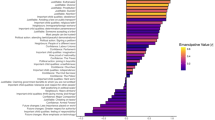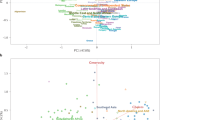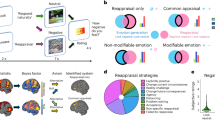Abstract
Over the past 10 years, Oosterhof and Todorov’s valence–dominance model has emerged as the most prominent account of how people evaluate faces on social dimensions. In this model, two dimensions (valence and dominance) underpin social judgements of faces. Because this model has primarily been developed and tested in Western regions, it is unclear whether these findings apply to other regions. We addressed this question by replicating Oosterhof and Todorov’s methodology across 11 world regions, 41 countries and 11,570 participants. When we used Oosterhof and Todorov’s original analysis strategy, the valence–dominance model generalized across regions. When we used an alternative methodology to allow for correlated dimensions, we observed much less generalization. Collectively, these results suggest that, while the valence–dominance model generalizes very well across regions when dimensions are forced to be orthogonal, regional differences are revealed when we use different extraction methods and correlate and rotate the dimension reduction solution.
Protocol registration
The stage 1 protocol for this Registered Report was accepted in principle on 5 November 2018. The protocol, as accepted by the journal, can be found at https://doi.org/10.6084/m9.figshare.7611443.v1.
This is a preview of subscription content, access via your institution
Access options
Access Nature and 54 other Nature Portfolio journals
Get Nature+, our best-value online-access subscription
$29.99 / 30 days
cancel any time
Subscribe to this journal
Receive 12 digital issues and online access to articles
$119.00 per year
only $9.92 per issue
Buy this article
- Purchase on Springer Link
- Instant access to full article PDF
Prices may be subject to local taxes which are calculated during checkout


Similar content being viewed by others
Data availability
Full data are publicly available at https://osf.io/87rbg/.
Code availability
Full analysis code is publicly available at https://osf.io/87rbg/.
References
Olivola, C. Y. & Todorov, A. Elected in 100 milliseconds: appearance-based trait inferences and voting. J. Nonverbal Behav. 34, 83–110 (2010).
Ritchie, K. L., Palermo, R. & Rhodes, G. Forming impressions of facial attractiveness is mandatory. Sci. Rep. 7, 469 (2017).
Willis, J. & Todorov, A. First impressions: making up your mind after 100 ms exposure to a face. Psychol. Sci. 17, 592–598 (2006).
Olivola, C. Y., Funk, F. & Todorov, A. Social attributions from faces bias human choices. Trends Cogn. Sci. 18, 566–570 (2014).
Todorov, A., Olivola, C. Y., Dotsch, R. & Mende-Siedlecki, P. Social attributions from faces: determinants, consequences, accuracy, and functional significance. Annu. Rev. Psychol. 66, 519–545 (2015).
Van ‘t Wout, M. & Sanfey, A. G. Friend or foe: the effect of implicit trustworthiness judgments in social decision-making. Cognition 108, 796–803 (2008).
Todorov, A., Mandisodza, A. N., Goren, A. & Hall, C. C. Inferences of competence from faces predict election outcomes. Science 308, 1623–1626 (2005).
Langlois, J. H. et al. Maxims or myths of beauty? A meta-analytic and theoretical review. Psychol. Bull. 126, 390–423 (2000).
Wilson, J. P. & Rule, N. O. Facial trustworthiness predicts extreme criminal-sentencing outcomes. Psychol. Sci. 26, 1325–1331 (2015).
Todorov, A., Said, C. P., Engell, A. D. & Oosterhof, N. N. Understanding evaluation of faces on social dimensions. Trends Cogn. Sci. 12, 455–460 (2008).
Jack, R. E. & Schyns, P. G. Toward a social psychophysics of face communication. Annu. Rev. Psychol. 68, 269–297 (2017).
Oosterhof, N. N. & Todorov, A. The functional basis of face evaluation. Proc. Natl Acad. Sci. USA 105, 11087–11092 (2008).
Morrison, D., Wang, H., Hahn, A. C., Jones, B. C. & DeBruine, L. M. Predicting the reward value of faces and bodies from social perception. PLoS ONE 12, e0185093 (2017).
Wang, H., Hahn, A. C., DeBruine, L. M. & Jones, B. C. The motivational salience of faces is related to both their valence and dominance. PLoS ONE 11, e0161114 (2016).
Henrich, J., Heine, S. & Norenzayan, A. The weirdest people in the world? Behav. Brain Sci. 33, 61–83 (2010).
Kline, M. A., Shamsudheen, R. & Broesch, T. Variation is the universal: making cultural evolution work in developmental psychology. Phil. Trans. R. Soc. B 373, 20170059 (2018).
Sutherland, C. A. M. et al. Facial first impressions across culture: data-driven modeling of Chinese and British perceivers’ unconstrained facial impressions. Pers. Soc. Psychol. Bull. 44, 521–537 (2018).
Wang, H. et al. A data-driven study of Chinese participants’ social judgments of Chinese faces. PLoS ONE 14, e0210315 (2019).
Han, C. et al. Cultural differences in preferences for facial coloration. Evol. Hum. Behav. 39, 154–159 (2018).
Perrett, D. I. et al. Effects of sexual dimorphism on facial attractiveness. Nature 394, 884–887 (1998).
Xie, S. Y., Flake, J. K. & Hehman, E.Perceiver and target characteristics contribute to impression formation differently across race and gender. J. Pers. Soc. Psychol. 117, 364–385 (2019).
Li, N. P., Valentine, K. A. & Patel, L. Mate preferences in the US and Singapore: a cross-cultural test of the mate preference priority model. Pers. Individ. Differ. 50, 291–294 (2011).
Ting-Toomey, S. in The Challenge of Facework: Cross-Cultural and Interpersonal Issues (ed. Ting-Toomey, S.) 1–14 (State Univ. New York Press, 1994).
Tan, C. B. Y., Stephen, I. D., Whitehead, R. & Sheppard, E. You look familiar: how Malaysian Chinese recognize faces. PLoS ONE 7, e29714 (2012).
Chartier, C., McCarthy, R. & Urry, H. The Psychological Science Accelerator (Association for Physical Science, 2018).
Chawla, D. S. A new ‘accelerator’ aims to bring big science to psychology. Science https://doi.org/10.1126/science.aar4464 (2017).
Moshontz, H. et al. The Psychological Science Accelerator: advancing psychology through a distributed collaborative network. Adv. Methods Pract. Psychol. Sci. 1, 501–515 (2018).
Widaman, K. F. On common factor and principal component representations of data: implications for theory and for confirmatory replications. Struct. Equ. Modeling 25, 829–847 (2018).
Hehman, E., Sutherland, C. A., Flake, J. K. & Slepian, M. L.The unique contributions of perceiver and target characteristics in person perception. J. Pers. Soc. Psychol. 113, 513–529 (2017).
Sutherland, C. A., Rhodes, G., Burton, N. S. & Young, A. W.Do facial first impressions reflect a shared social reality? Br. J. Psychol. 111, 215–232 (2020).
Oh, D., Dotsch, R., Porter, J. & Todorov, A.Gender biases in impressions from faces: empirical studies and computational models. J. Exp. Psychol. Gen. 149, 323–342 (2020).
Oh, D., Shafir, E. & Todorov, A. Economic status cues from clothes affect perceived competence from faces. Nat. Hum. Behav. 4, 287–293 (2020).
Collova, J. R., Sutherland, C. A. & Rhodes, G. Testing the functional basis of first impressions: dimensions for children’s faces are not the same as for adults’ faces. J. Pers. Soc. Psychol. 117, 900–924 (2019).
Stolier, R. M., Hehman, E., Keller, M. D., Walker, M. & Freeman, J. B. The conceptual structure of face impressions. Proc. Natl Acad. Sci. USA 115, 9210–9215 (2018).
Stolier, R. M., Hehman, E. & Freeman, J. B. A dynamic structure of social trait space. Trends Cogn. Sci. 22, 197–200 (2018).
Ma, D. S., Correll, J. & Wittenbrink, B. The Chicago Face Database: a free stimulus set of faces and norming data. Behav. Res. Methods 47, 1122–1135 (2015).
Bainbridge, W. A., Isola, P. & Oliva, A. The intrinsic memorability of face photographs. J. Exp. Psychol. Gen. 142, 1323–1334 (2013).
Sutherland, C. A. et al. Social inferences from faces: ambient images generate a three-dimensional model. Cognition 127, 105–118 (2013).
Burt, C. The factorial study of temperament traits. Br. J. Psychol. Stat. Sect. 1, 178–203 (1948).
Tucker, L. R. A Method for Synthesis of Factor Analysis Studies Personnel Research Section Report No. 984 (Department of the Army, 1951).
Davenport, E. C. Jr Significance testing of congruence coefficients: a good idea? Educ. Psychol. Meas. 50, 289–296 (1990).
Lorenzo-Seva, U. & ten Berge, J. M. F. Tucker’s congruence coefficient as a meaningful index of factor similarity. Methodology 2, 57–64 (2006).
Fabrigar, L. R., Wegener, D. T., MacCallum, R. C. & Strahan, E. J. Evaluating the use of exploratory factor analysis in psychological research. Psychol. Methods 4, 272–299 (1999).
Park, H. S., Dailey, R. & Lemus, D. The use of exploratory factor analysis and principal components analysis in communication research. Hum. Commun. Res. 28, 562–577 (2002).
Cliff, N. The eigenvalues-greater-than-one rule and the reliability of components. Psychol. Bull. 103, 276–279 (1988).
Zwick, W. R. & Velicer, W. F. Comparison of five rules for determining the number of components to retain. Psychol. Bull. 99, 432–442 (1986).
O’Connor, B. P. SPSS and SAS programs for determining the number of components using parallel analysis and Velicer’s MAP test. Behav. Res. Methods Instrum. Comput. 32, 396–402 (2000).
Schmitt, T. A. Current methodological considerations in exploratory and confirmatory factor analysis. J. Psychoeduc. Assess. 29, 304–321 (2011).
Courtney, M. G. R. Determining the number of factors to retain in EFA: using the SPSS R-Menu v2.0 to make more judicious estimations. Pract. Assess. Res. Eval. 18, 1–14 (2013).
Acknowledgements
C.L. was supported by the Vienna Science and Technology Fund (WWTF VRG13-007); L.M.D. was supported by ERC 647910 (KINSHIP); D.I.B. and N.I. received funding from CONICET, Argentina; L.K., F.K. and Á. Putz were supported by the European Social Fund (EFOP-3.6.1.-16-2016-00004; ‘Comprehensive Development for Implementing Smart Specialization Strategies at the University of Pécs’). K.U. and E. Vergauwe were supported by a grant from the Swiss National Science Foundation (PZ00P1_154911 to E. Vergauwe). T.G. is supported by the Social Sciences and Humanities Research Council of Canada (SSHRC). M.A.V. was supported by grants 2016-T1/SOC-1395 (Comunidad de Madrid) and PSI2017-85159-P (AEI/FEDER UE). K.B. was supported by a grant from the National Science Centre, Poland (number 2015/19/D/HS6/00641). J. Bonick and J.W.L. were supported by the Joep Lange Institute. G.B. was supported by the Slovak Research and Development Agency (APVV-17-0418). H.I.J. and E.S. were supported by a French National Research Agency ‘Investissements d’Avenir’ programme grant (ANR-15-IDEX-02). T.D.G. was supported by an Australian Government Research Training Program Scholarship. The Raipur Group is thankful to: (1) the University Grants Commission, New Delhi, India for the research grants received through its SAP-DRS (Phase-III) scheme sanctioned to the School of Studies in Life Science; and (2) the Center for Translational Chronobiology at the School of Studies in Life Science, PRSU, Raipur, India for providing logistical support. K. Ask was supported by a small grant from the Department of Psychology, University of Gothenburg. Y.Q. was supported by grants from the Beijing Natural Science Foundation (5184035) and CAS Key Laboratory of Behavioral Science, Institute of Psychology. N.A.C. was supported by the National Science Foundation Graduate Research Fellowship (R010138018). We acknowledge the following research assistants: J. Muriithi and J. Ngugi (United States International University Africa); E. Adamo, D. Cafaro, V. Ciambrone, F. Dolce and E. Tolomeo (Magna Græcia University of Catanzaro); E. De Stefano (University of Padova); S. A. Escobar Abadia (University of Lincoln); L. E. Grimstad (Norwegian School of Economics (NHH)); L. C. Zamora (Franklin and Marshall College); R. E. Liang and R. C. Lo (Universiti Tunku Abdul Rahman); A. Short and L. Allen (Massey University, New Zealand), A. Ateş, E. Güneş and S. Can Özdemir (Boğaziçi University); I. Pedersen and T. Roos (Åbo Akademi University); N. Paetz (Escuela de Comunicación Mónica Herrera); J. Green (University of Gothenburg); M. Krainz (University of Vienna, Austria); and B. Todorova (University of Vienna, Austria). The funders had no role in study design, data collection and analysis, decision to publish or preparation of the manuscript.
Author information
Authors and Affiliations
Contributions
Conceptualization: B.C.J., L.M.D., J.K.F., J.P.W., J.B.F., S.Á.-S., H.I., S.M.J.J., H.L.
Data curation: B.C.J., L.M.D., N.C.A., N.G.B., Y.Q., J.W.L., K.G., G.M.M., J.G.L., J.B.F., P.C., A.P., N.P., S.P., M.M.S., B.P., M.J.B., V.K., J.P., D.S., S.C.W., J.V.V., P.S.F., C.R.C., N.A.C.
Formal analysis: B.C.J., L.M.D., J.K.F., Y.Q., J.B.F.
Funding acquisition: N.C.O., Y.Q., J.W.L., C.C., J. Leongómez, O.R.S., E. Valderrama, M.V.-A., J.G.L., M.C.P., J.B.F., J.K.O., G.K., H.I., H.D.F., T.J.S.L., E. Vergauwe, K. Ask, K.W.T., M.I., C.L., P.S.F., C.R.C.
Investigation: B.C.J., L.M.D., M.T.L., J.A., I.L.G.N., N.G.B., S.C.L., F.F., M.L.W., C.P.C., M.A.V., S.A.S., N.C.O., D.P.C., A.W., Y.Q., H.M., P. Suavansri, T.R.E., J. Bonick, J.W.L., C.C., A. Kapucu, A. Karaaslan, J. Leongómez, O.R.S., E. Valderrama, M.V.-A., B.A., P. Szecsi, M. Andreychik, E.D.M., C.B., C.-P.H., Q.-L.L., L.A.V., K.B., K.G., I.S., S.S., R.A., C.M., W.V., Z.J., Q.W., G.M.M., I.D.S., J.G.L., M.C.P., J.D.A., E.H., S.Y.X., W.J.C., M. Seehuus, J.P.W., E.K., M.P.-P., A.E.B.-S., A.d.-G., I.G.-S., H.-H.W., J.B.F., D.W.O., V.S., T.E.S., C.A.L., C.L.C., A.K.P., J. Bavolar, P. Kačmár, I. Zakharov, S.Á.-S., E.B., M.T., K.S., C.D.C., J.W.S., J.K.O., A.-S.L., T.D.G., J.A.O., B.J.W.D., L.M.S., G.R., M.J.B., B.J., D.R., G.K., V.A.F., H.L.U., S.-C.C., G.P., Z.V., D.M.B.-B., H.I., N.V.d.L., C.B.Y.T., V.K., M.F.C., H.D.F., D.I.B., G.G., J.P., C.S., K.A.Ś., E.M.O.K., D.S., B.S., M. Sirota, G.V.S., T.J.S.L., K.U., E. Vergauwe, J.S., K. Ask, C.J.J.v.Z., A. Körner, S.C.W., J. Boudesseul, F.R.-D., K.L.R., N.M.M., K.R.B., D.W., A.R.G.-F., M. Anne, S.M.J.J., K.M.L., T.K.N., C.K.T., J.H.Z., A.D.R., L.K., M. Vianello, N.I., A.C., S.L., J. Lutz, M. Adamkovic, P.B., G.B., I.R., V.C., K.P., N.K.S., K.W.T., C.A.T., A.M.F., R.M.C.S.H., J.V.V., N.S.C.-F., M.F.-A., J.H., A.M., M. Sharifian, B.F., H.L., M.I., C.L., E.P., M. Voracek, J.O., E.M.G., A.A., A.A.Ö., M.T.C., B.B.-D., M.A.K., C.O., T.G., J.K.M., Y.D., X.Y., S. Alper, P.S.F., C.R.C., N.A.C.
Methodology: B.C.J., L.M.D., J.K.F., S.C.L., L.A.V., M. Seehuus, S. Azouaghe, A.B., J.E., J.P.W., J.B.F., C.A.L., C.D.C., K.H., B.J., J.W., G.K., H.I., T.B., N.V.d.L., H.D.F., J.P., F.M.A.W., S.M.J.J., H.L.
Project administration: B.C.J., L.M.D., N.G.B., S.C.L., M.L.W., M.G., A.S., N.C.O., A.W., Y.Q., H.M., R.M.S., J. Bonick, J.W.L., C.C., A. Kapucu, A. Karaaslan, J. Leongómez, O.R.S., E. Valderrama, M.V.-A., B.A., C.B., C.-P.H., L.A.V., K.B., K.G., I.S., S.S., I.D.S., M.C.P., S.Y.X., W.J.C., M. Seehuus, A.d.-G., I.G.-S., C.-C.K., J.B.F., D.W.O., C.A.L., J. Bavolar, P. Kačmár, I. Zakharov, K.S., C.D.C., J.W.S., J.L.B., J.A.O., B.J.W.D., M.J.B., B.J., D.R., G.P., Z.V., E.S., N.V.d.L., V.K., M.F.C., H.D.F., J.P., C.S., K.A.S., E.M.O.K., B.S., M. Sirota, T.J.S.L., K.U., E. Vergauwe, K. Ask, C.J.J.v.Z., S.C.W., J. Boudesseul, F.R.-D., K.L.R., D.W., S.M.J.J., C.K.T., J.H.Z., L.K., S.L., V.C., N.K.S., K.W.T., R.M.C.S.H., J.V.V., A.M., M. Sharifian, B.F., H.L., C.L., E.P., M. Voracek, A.A., A.A.Ö., M.A.K., T.G., X.Y., S. Alper, P.S.F., C.R.C., N.A.C.
Resources: B.C.J., L.M.D., M.T.L., S.C.L., C.P.C., M.A.V., S.A.S., A.W., Y.Q., K. Ariyabuddhiphongs, S.J., H.M., P. Suavansri, N.T., R.M.S., C.C., A. Kapucu, J. Leongómez, M.V.-A., N.H., C.B., L.A.V., K.B., K.G., Z.J., G.M.M., I.D.S., J.G.L., S.Y.X., W.J.C., M. Seehuus, S. Azouaghe, A.B., J.E., A.d.-G., C.-C.K., J.B.F., C.A.L., A.K.P., P. Kačmár, I. Zakharov, E.B., K.S., C.D.C., J.K.O., J.L.B., B.J.W.D., D.R., W.W.A.S., S.-C.C., G.P., D.M.B.-B., T.B., C.B.Y.T., V.K., H.D.F., G.G., C.S., K.A.S., E.M.O.K., B.S., M. Sirota, G.V.S., T.J.S.L., K.U., E. Vergauwe, K.J., K. Ask, J. Boudesseul, F.R.-D., N.M.M., S.M.J.J., C.K.T., A.D.R., F.K., Á.P., P.T., M. Vianello, A.C., S.L., J. Lutz, M. Adamkovic, P.B., V.C., A.M.F., R.M.C.S.H., J.V.V., N.S.C.-F., M.F.-A., A.M., M. Sharifian, H.L., C.L., M. Voracek, E.M.G., A.A.Ö., M.A.K., C.O., X.Y., S. Alper, P.S.F., C.R.C. Software: B.C.J., L.M.D., J.K.F., G.M.M., I.D.S., N.P., B.P., C.D.C., H.D.F., C.S., K.R.B., R.M.C.S.H., C.R.C., N.A.C. Supervision: B.C.J., L.M.D., J.K.F., M.T.L., S.C.L., M.L.W., N.C.O., A.W., H.M., J.W.L., C.C., A. Kapucu, J. Leongómez, O.R.S., E. Valderrama, M.V.-A., M. Andreychik, E.D.M., C.B., L.A.V., K.B., I.D.S., M.C.P., E.H., W.J.C., M. Seehuus, C.-C.K., J.B.F., C.A.L., P. Kačmár, I. Zakharov, K.S., C.D.C., J.W.S., J.K.O., A.-S.L., J.L.B., J.A.O., B.J.W.D., M.J.B., H.I., V.K., M.F.C., H.D.F., J.P., C.S., E.M.O.K., D.S., B.S., M. Sirota, T.J.S.L., K.U., E. Vergauwe, K. Ask, C.J.J.v.Z., D.W., S.M.J.J., A.C., S.L., K.P., N.K.S., K.W.T., A.M.F., J.V.V., M. Sharifian, M.I., C.L., M. Voracek, A.A., A.A.Ö., M.A.K., S. Alper, P.S.F., C.R.C., N.A.C.
Validation: B.C.J., L.M.D., J.K.F., C.C., Q.W., S.Y.X., M. Seehuus, C.L.C., A.K.P., I. Zakharov, J.W.S., E.S., V.K., H.D.F., J.P., M. Sirota, E. Vergauwe, C.J.J.v.Z., P.T., J.H., M. Voracek, M.A.K.
Visualization: B.C.J., L.M.D., J.K.F., H.D.F., M.A.K., P.S.F. Writing (original draft): B.C.J., L.M.D., J.K.F., F.F., Y.Q., C.B., I.G.-S., J.B.F., K.S., B.J.W.D., G.K., H.L.U., H.I., H.D.F., D.I.B., J.P., C.S., D.S., K.L.R., S.M.J.J., A.D.R., N.K.S., J.O., A.A.Ö., M.A.K., P.S.F., N.A.C.
Writing (review & editing): B.C.J., L.M.D., J.K.F., M.T.L., J.A., I.L.G.N., S.C.L., F.F., M.L.W., M.A.V., A.S., D.P.C., A.W., Y.Q., K. Ariyabuddhiphongs, H.M., T.R.E., J. Bonick, J.W.L., C.C., J. Leongómez, B.A., N.H., P. Szecsi, M. Andreychik, E.D.M., C.B., N.L., L.A.V., K.B., I.S., S.S., Z.J., I.D.S., M.C.P., J.D.A., E.H., S.Y.X., W.J.C., M. Seehuus, S. Azouaghe, A.B., J.E., J.P.W., E.K., M.P.-P., A.E.B.-S., A.d.-G., J.B.F., V.S., T.E.S., C.A.L., C.L.C., P.C., P. Kujur, A.P., N.P., A.K.P., S.P., M.M.S., B.P., P. Kačmár, I. Zakharov, S.Á.-S., E.B., M.T., K.S., C.D.C., J.W.S., J.K.O., A.-S.L., J.L.B., T.D.G., J.A.O., B.J.W.D., G.R., M.J.B., K.H., B.J., G.K., V.A.F., H.L.U., G.P., Z.V., H.I., T.B., N.V.d.L., C.B.Y.T., V.K., M.F.C., H.D.F., D.I.B., G.G., C.S., E.M.O.K., D.S., B.S., M. Sirota, T.J.S.L., K.U., E. Vergauwe, J.S., K. Ask, C.J.J.v.Z., A. Körner, K.L.R., K.R.B., D.W., A.R.G.-F., S.M.J.J., T.K.N., C.K.T., J.H.Z., M. Vianello, N.I., M. Adamkovic, G.B., I.R., V.C., K.P., N.K.S., K.W.T., C.A.T., A.M.F., R.M.C.S.H., J.V.V., B.F., H.L., C.L., E.P., M. Voracek, J.O., E.M.G., A.A., A.A.Ö., B.B.-D., M.A.K., T.G., J.K.M., Y.D., P.S.F., C.R.C., N.A.C.
The following people did not indicate specific contributions: A.F.D., A.C.H., A.D.L.R.-G., D.R.F., D.T., E.T., E.G.-S., H.I.J., I. Zettler, I.R.P., J.A.M.-R., J.D.L., L.N., L.F.A., M.A.C.V., M.M.A., M.L.B.-G., M.H.S., N.O.R., P.P., P.F., R.J.M., S.G., S.J.C., T.H., V.K.M.S., W.-J.Y.
Corresponding author
Ethics declarations
Competing interests
The authors declare no competing interests.
Additional information
Peer review information Primary Handling Editor: Stavroula Kousta.
Supplementary information
Supplementary Information
Full output and code.
Rights and permissions
About this article
Cite this article
Jones, B.C., DeBruine, L.M., Flake, J.K. et al. To which world regions does the valence–dominance model of social perception apply?. Nat Hum Behav 5, 159–169 (2021). https://doi.org/10.1038/s41562-020-01007-2
Received:
Accepted:
Published:
Issue Date:
DOI: https://doi.org/10.1038/s41562-020-01007-2
This article is cited by
-
Assessing the roles of shape prototypicality and sexual dimorphism in ratings of the trustworthiness of faces
Scientific Reports (2023)
-
Establishing psychological universals
Nature Reviews Psychology (2023)
-
‘Big team’ science challenges us to reconsider authorship
Nature Human Behaviour (2023)
-
Examining the “attractiveness halo effect” across cultures
Current Psychology (2023)
-
Evidence against the “anomalous-is-bad” stereotype in Hadza hunter gatherers
Scientific Reports (2022)



